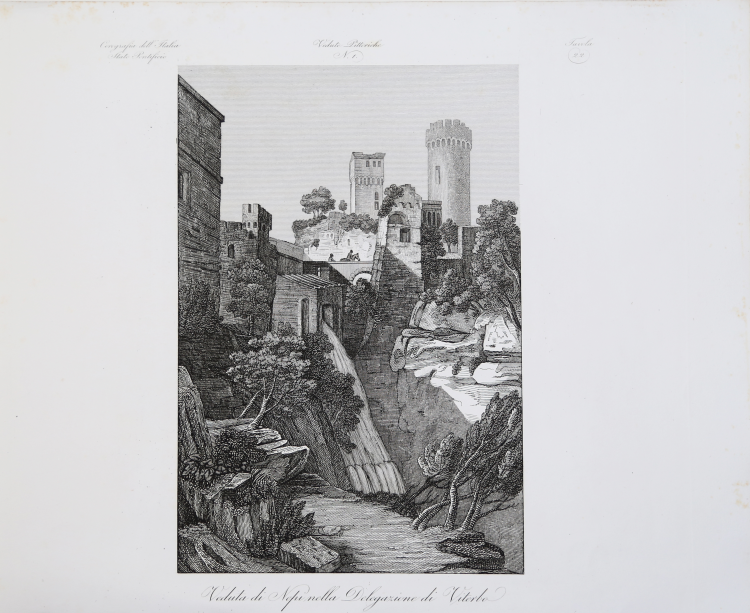



| Reference: | S41723.321 |
| Author | Attilio ZUCCAGNI ORLANDINI |
| Year: | 1845 |
| Zone: | Nepi |
| Printed: | Florence |
| Measures: | 385 x 330 mm |


| Reference: | S41723.321 |
| Author | Attilio ZUCCAGNI ORLANDINI |
| Year: | 1845 |
| Zone: | Nepi |
| Printed: | Florence |
| Measures: | 385 x 330 mm |
View published in the famous Atlante illustrativo, ossia Raccolta dei principali monumenti italiani antichi, del Medio evo e moderni, e di alcune vedute pittoriche... di Attilio Zuccagni-Orlandini, published in 3 volumes in Florence, 1845, to accompany the Corografia fisica, storica e statistica dell'Italia..., a work in 12 volumes, published from 1837 to 1845, accompanied - in addition to the Atlante illustrativo described above - also by a Atlante geografico degli Stati italiani, in two volumes.
Attilio Zuccagni Orlandini (1784-1872) was born in Fiesole under the name of Giuseppe Orlandini. Following adoption by his wealthy maternal uncle Attilio Zuccagni (1754-1807), a botanist and georgofile, he took the name Attilio Zuccagni Orlandini.
His most important work is the geographic-cartographic report of all the pre-unification Italian states, the great Corografia fisica, storica e statistica dell'Italia e delle sue Isole (Florence 1835-1845), in twelve volumes for nineteen tomes, with an introductory volume on the entire Italian peninsula. The work constituted the sum of hundreds of general, regional and local geographic works then available and presented, for each pre-unification state, the physical, historical, topographical and statistical framework. In 1844-45, the Corografia was enriched with five volumes of maps, views and other illustrations of places and monuments: Atlante geografico degli Stati italiani delineato sopra le migliori e più moderne mappe (two volumes with 144 plates including the large map of the peninsula in 15 sheets) and Atlante illustrativo ossia raccolta dei principali monumenti italiani antichi, del medio evo e moderni e di alcune vedute pittoriche (three volumes with 413 illustrations, printed on 269 sheets). The plates were engraved, again in Florence, in two special workshops, by four talented Lombard artists (Vittorio Angeli, Giacinto Maina, Pietro Manzoni and Giuseppe Pozzi).
Especially the first of the two atlases represents, even today, a milestone in the history of cartography and Italian geographic iconography. It was truly 'an arduous undertaking', since cartographic products were often still lacking (as, for example, for the Duchy of Lucca and the Papal States) fully geometric. The two products were presented to the Georgofili in 1843 and 1844, along with the map of the Republic of San Marino. The work proved to be very expensive and did not achieve the commercial success hoped for, but served as a basis for many other subsequent publishing initiatives that drew on it, sometimes without even respecting the copyright.
Etching, in excellent condition.
Literature:
Anna Guarducci - Dizionario Biografico degli Italiani - Volume 100 (2020).
Attilio ZUCCAGNI ORLANDINI (Fiesole 1784 - Firenze 1872)
|
Attilio Zuccagni Orlandini (Fiesole 1784-Firenze 1872), who realized the great Atlante Geografico Fisico e Storico of Tuscany, consisting of 20 big plates with explicatory text and published between 1828 and 1832, prolonged to the whole Italian peninsula a graphic and descriptive illustration, published in 1845, consisting of 19 books and a big atlas in 5 in folio volumes, called "Corografia Fisica, Storica e Statistica dell'Italia e delle sue Isole" supplied with the "Atlante illustrativo ossia Raccolta dei principali monumenti italiani antichi, del Medio Evo e moderni e di alcune vedute pittoriche per servire di corredo alla corografia fisica storica e statistica dell’Italia di Attilio Zuccagni-Orlandini". The work has been published in Florence by the Società Editrice between 1842-45. Giacinto Maina, Valerio Stanghi, Antonio Verico and others engraved the plates.
|
Attilio ZUCCAGNI ORLANDINI (Fiesole 1784 - Firenze 1872)
|
Attilio Zuccagni Orlandini (Fiesole 1784-Firenze 1872), who realized the great Atlante Geografico Fisico e Storico of Tuscany, consisting of 20 big plates with explicatory text and published between 1828 and 1832, prolonged to the whole Italian peninsula a graphic and descriptive illustration, published in 1845, consisting of 19 books and a big atlas in 5 in folio volumes, called "Corografia Fisica, Storica e Statistica dell'Italia e delle sue Isole" supplied with the "Atlante illustrativo ossia Raccolta dei principali monumenti italiani antichi, del Medio Evo e moderni e di alcune vedute pittoriche per servire di corredo alla corografia fisica storica e statistica dell’Italia di Attilio Zuccagni-Orlandini". The work has been published in Florence by the Società Editrice between 1842-45. Giacinto Maina, Valerio Stanghi, Antonio Verico and others engraved the plates.
|